Zhishen Huang
Enhancing Low-dose CT Image Reconstruction by Integrating Supervised and Unsupervised Learning
Nov 19, 2023



Abstract:Traditional model-based image reconstruction (MBIR) methods combine forward and noise models with simple object priors. Recent application of deep learning methods for image reconstruction provides a successful data-driven approach to addressing the challenges when reconstructing images with undersampled measurements or various types of noise. In this work, we propose a hybrid supervised-unsupervised learning framework for X-ray computed tomography (CT) image reconstruction. The proposed learning formulation leverages both sparsity or unsupervised learning-based priors and neural network reconstructors to simulate a fixed-point iteration process. Each proposed trained block consists of a deterministic MBIR solver and a neural network. The information flows in parallel through these two reconstructors and is then optimally combined. Multiple such blocks are cascaded to form a reconstruction pipeline. We demonstrate the efficacy of this learned hybrid model for low-dose CT image reconstruction with limited training data, where we use the NIH AAPM Mayo Clinic Low Dose CT Grand Challenge dataset for training and testing. In our experiments, we study combinations of supervised deep network reconstructors and MBIR solver with learned sparse representation-based priors or analytical priors. Our results demonstrate the promising performance of the proposed framework compared to recent low-dose CT reconstruction methods.
Reinforcement Learning for Sampling on Temporal Medical Imaging Sequences
Aug 28, 2023



Abstract:Accelerated magnetic resonance imaging resorts to either Fourier-domain subsampling or better reconstruction algorithms to deal with fewer measurements while still generating medical images of high quality. Determining the optimal sampling strategy given a fixed reconstruction protocol often has combinatorial complexity. In this work, we apply double deep Q-learning and REINFORCE algorithms to learn the sampling strategy for dynamic image reconstruction. We consider the data in the format of time series, and the reconstruction method is a pre-trained autoencoder-typed neural network. We present a proof of concept that reinforcement learning algorithms are effective to discover the optimal sampling pattern which underlies the pre-trained reconstructor network (i.e., the dynamics in the environment). The code for replicating experiments can be found at https://github.com/zhishenhuang/RLsamp.
Combining Deep Learning and Adaptive Sparse Modeling for Low-dose CT Reconstruction
May 19, 2022



Abstract:Traditional model-based image reconstruction (MBIR) methods combine forward and noise models with simple object priors. Recent application of deep learning methods for image reconstruction provides a successful data-driven approach to addressing the challenges when reconstructing images with measurement undersampling or various types of noise. In this work, we propose a hybrid supervised-unsupervised learning framework for X-ray computed tomography (CT) image reconstruction. The proposed learning formulation leverages both sparsity or unsupervised learning-based priors and neural network reconstructors to simulate a fixed-point iteration process. Each proposed trained block consists of a deterministic MBIR solver and a neural network. The information flows in parallel through these two reconstructors and is then optimally combined, and multiple such blocks are cascaded to form a reconstruction pipeline. We demonstrate the efficacy of this learned hybrid model for low-dose CT image reconstruction with limited training data, where we use the NIH AAPM Mayo Clinic Low Dose CT Grand Challenge dataset for training and testing. In our experiments, we study combinations of supervised deep network reconstructors and sparse representations-based (unsupervised) learned or analytical priors. Our results demonstrate the promising performance of the proposed framework compared to recent reconstruction methods.
Multi-layer Clustering-based Residual Sparsifying Transform for Low-dose CT Image Reconstruction
Mar 22, 2022

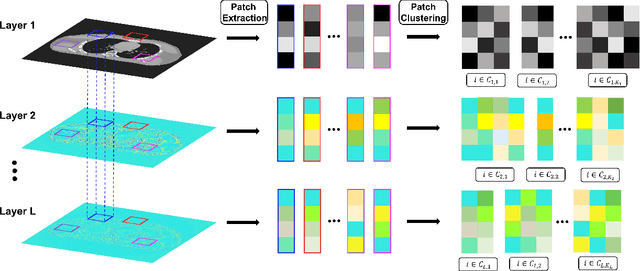

Abstract:The recently proposed sparsifying transform models incur low computational cost and have been applied to medical imaging. Meanwhile, deep models with nested network structure reveal great potential for learning features in different layers. In this study, we propose a network-structured sparsifying transform learning approach for X-ray computed tomography (CT), which we refer to as multi-layer clustering-based residual sparsifying transform (MCST) learning. The proposed MCST scheme learns multiple different unitary transforms in each layer by dividing each layer's input into several classes. We apply the MCST model to low-dose CT (LDCT) reconstruction by deploying the learned MCST model into the regularizer in penalized weighted least squares (PWLS) reconstruction. We conducted LDCT reconstruction experiments on XCAT phantom data and Mayo Clinic data and trained the MCST model with 2 (or 3) layers and with 5 clusters in each layer. The learned transforms in the same layer showed rich features while additional information is extracted from representation residuals. Our simulation results demonstrate that PWLS-MCST achieves better image reconstruction quality than the conventional FBP method and PWLS with edge-preserving (EP) regularizer. It also outperformed recent advanced methods like PWLS with a learned multi-layer residual sparsifying transform prior (MARS) and PWLS with a union of learned transforms (ULTRA), especially for displaying clear edges and preserving subtle details.
Single-pass Object-adaptive Data Undersampling and Reconstruction for MRI
Nov 17, 2021



Abstract:There is much recent interest in techniques to accelerate the data acquisition process in MRI by acquiring limited measurements. Often sophisticated reconstruction algorithms are deployed to maintain high image quality in such settings. In this work, we propose a data-driven sampler using a convolutional neural network, MNet, to provide object-specific sampling patterns adaptive to each scanned object. The network observes very limited low-frequency k-space data for each object and rapidly predicts the desired undersampling pattern in one go that achieves high image reconstruction quality. We propose an accompanying alternating-type training framework with a mask-backward procedure that efficiently generates training labels for the sampler network and jointly trains an image reconstruction network. Experimental results on the fastMRI knee dataset demonstrate the ability of the proposed learned undersampling network to generate object-specific masks at fourfold and eightfold acceleration that achieve superior image reconstruction performance than several existing schemes. The source code for the proposed joint sampling and reconstruction learning framework is available at https://github.com/zhishenhuang/mri.
Physics-Driven Learning of Wasserstein GAN for Density Reconstruction in Dynamic Tomography
Oct 28, 2021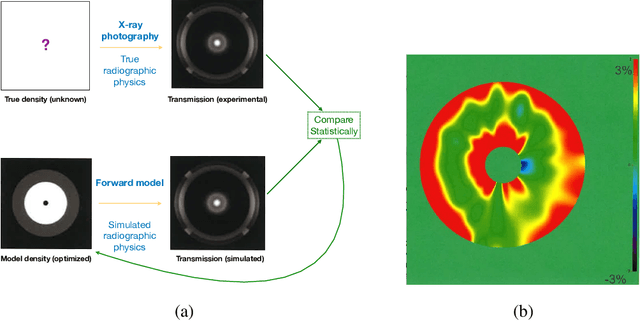
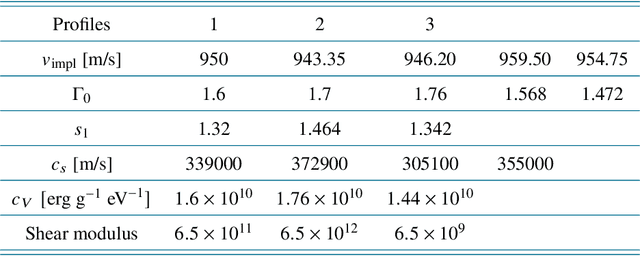
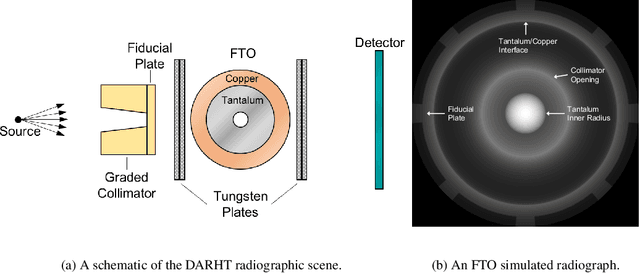
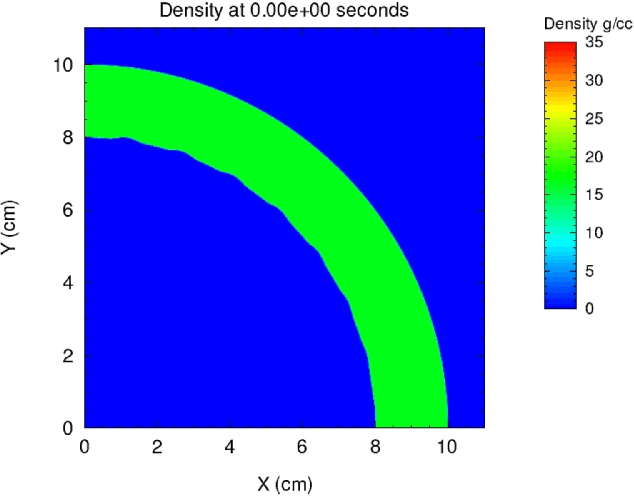
Abstract:Object density reconstruction from projections containing scattered radiation and noise is of critical importance in many applications. Existing scatter correction and density reconstruction methods may not provide the high accuracy needed in many applications and can break down in the presence of unmodeled or anomalous scatter and other experimental artifacts. Incorporating machine-learned models could prove beneficial for accurate density reconstruction particularly in dynamic imaging, where the time-evolution of the density fields could be captured by partial differential equations or by learning from hydrodynamics simulations. In this work, we demonstrate the ability of learned deep neural networks to perform artifact removal in noisy density reconstructions, where the noise is imperfectly characterized. We use a Wasserstein generative adversarial network (WGAN), where the generator serves as a denoiser that removes artifacts in densities obtained from traditional reconstruction algorithms. We train the networks from large density time-series datasets, with noise simulated according to parametric random distributions that may mimic noise in experiments. The WGAN is trained with noisy density frames as generator inputs, to match the generator outputs to the distribution of clean densities (time-series) from simulations. A supervised loss is also included in the training, which leads to improved density restoration performance. In addition, we employ physics-based constraints such as mass conservation during network training and application to further enable highly accurate density reconstructions. Our preliminary numerical results show that the models trained in our frameworks can remove significant portions of unknown noise in density time-series data.
Model-based Reconstruction with Learning: From Unsupervised to Supervised and Beyond
Mar 26, 2021


Abstract:Many techniques have been proposed for image reconstruction in medical imaging that aim to recover high-quality images especially from limited or corrupted measurements. Model-based reconstruction methods have been particularly popular (e.g., in magnetic resonance imaging and tomographic modalities) and exploit models of the imaging system's physics together with statistical models of measurements, noise and often relatively simple object priors or regularizers. For example, sparsity or low-rankness based regularizers have been widely used for image reconstruction from limited data such as in compressed sensing. Learning-based approaches for image reconstruction have garnered much attention in recent years and have shown promise across biomedical imaging applications. These methods include synthesis dictionary learning, sparsifying transform learning, and different forms of deep learning involving complex neural networks. We briefly discuss classical model-based reconstruction methods and then review reconstruction methods at the intersection of model-based and learning-based paradigms in detail. This review includes many recent methods based on unsupervised learning, and supervised learning, as well as a framework to combine multiple types of learned models together.
Stochastic Gradient Langevin Dynamics with Variance Reduction
Feb 12, 2021


Abstract:Stochastic gradient Langevin dynamics (SGLD) has gained the attention of optimization researchers due to its global optimization properties. This paper proves an improved convergence property to local minimizers of nonconvex objective functions using SGLD accelerated by variance reductions. Moreover, we prove an ergodicity property of the SGLD scheme, which gives insights on its potential to find global minimizers of nonconvex objectives.
Spectral estimation from simulations via sketching
Jul 21, 2020



Abstract:Sketching is a stochastic dimension reduction method that preserves geometric structures of data and has applications in high-dimensional regression, low rank approximation and graph sparsification. In this work, we show that sketching can be used to compress simulation data and still accurately estimate time autocorrelation and power spectral density. For a given compression ratio, the accuracy is much higher than using previously known methods. In addition to providing theoretical guarantees, we apply sketching to a molecular dynamics simulation of methanol and find that the estimate of spectral density is 90% accurate using only 10% of the data.
Perturbed Proximal Descent to Escape Saddle Points for Non-convex and Non-smooth Objective Functions
Jan 24, 2019


Abstract:We consider the problem of finding local minimizers in non-convex and non-smooth optimization. Under the assumption of strict saddle points, positive results have been derived for first-order methods. We present the first known results for the non-smooth case, which requires different analysis and a different algorithm.
 Add to Chrome
Add to Chrome Add to Firefox
Add to Firefox Add to Edge
Add to Edge